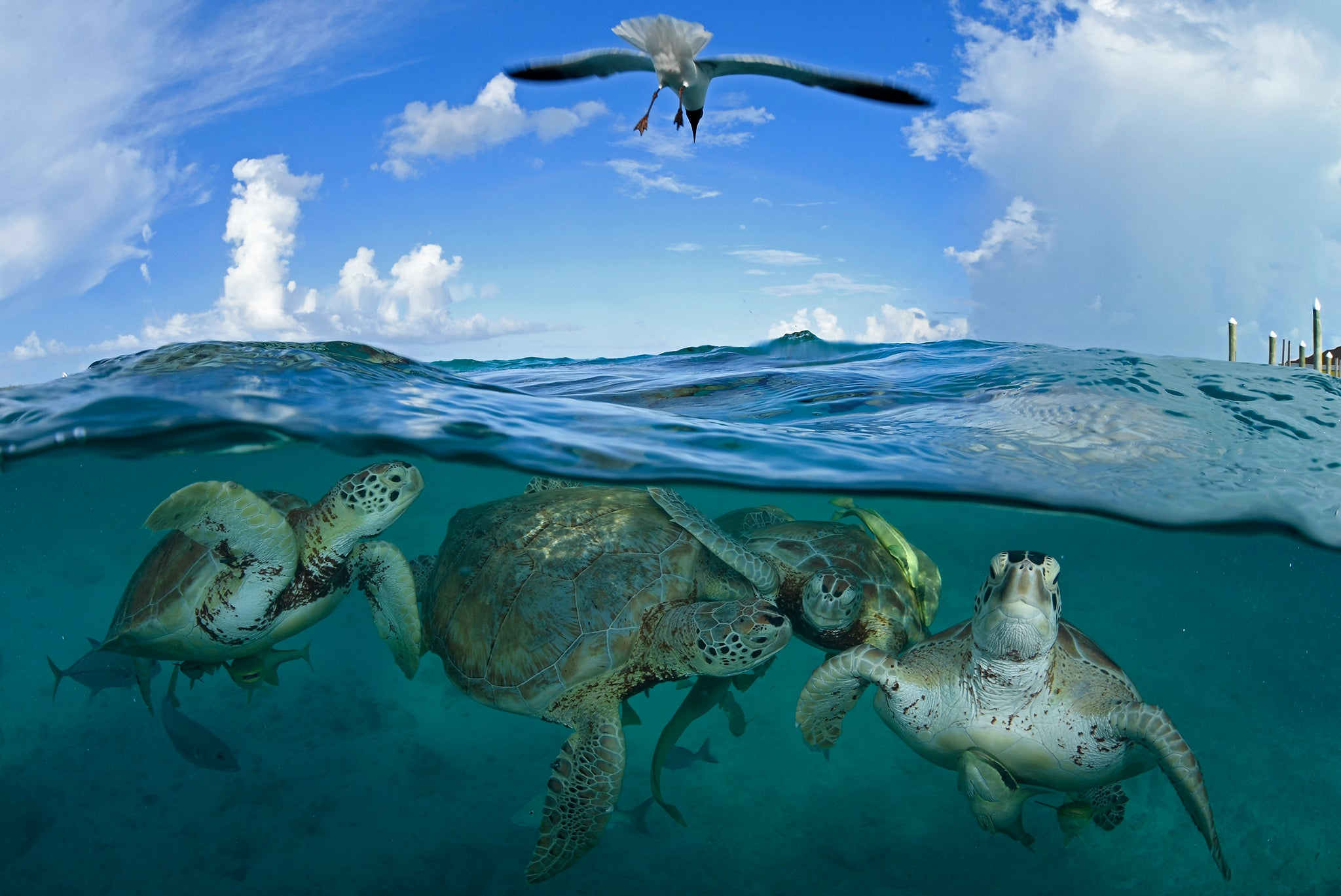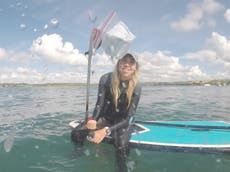Discarded masks infecting oceans as side effect of Covid pandemic
'Significant portion’ of billions of masks and gloves used each month end up in seas

Your support helps us to tell the story
From reproductive rights to climate change to Big Tech, The Independent is on the ground when the story is developing. Whether it's investigating the financials of Elon Musk's pro-Trump PAC or producing our latest documentary, 'The A Word', which shines a light on the American women fighting for reproductive rights, we know how important it is to parse out the facts from the messaging.
At such a critical moment in US history, we need reporters on the ground. Your donation allows us to keep sending journalists to speak to both sides of the story.
The Independent is trusted by Americans across the entire political spectrum. And unlike many other quality news outlets, we choose not to lock Americans out of our reporting and analysis with paywalls. We believe quality journalism should be available to everyone, paid for by those who can afford it.
Your support makes all the difference.The pale blue of a mask is easy to spot among the dry-brown reeds.
People walk here along the northern coast of the San Francisco Bay, crowding a path that bends to the contour of the shore. At the small pebble beach near a park called Blackies Pasture, a surgical mask is tangled in the marsh at the edge of the Bay. A little further on is another, then another on the other side of the path, waiting to be blown into the sea.
"I mean this is a high-wealth area and even here you see it," said Peter Ottesen, a fit 74-year-old tossing the ball to his black lab, Addie, on a recent clear morning. "It's now like cigarette butts or anything else. You see it on the sides of the path, the sides of the road, and if you don't see it, you are not looking."
There is the economic crash, the education gap, the depression of solitary life. Now another unwelcome and potentially enduring side effect of the coronavirus pandemic has emerged: the masks, gloves, disinfectant wipes and other items of "personal protective equipment" meant to save lives are also polluting the environment.
Since the pandemic began early this year, masks have become a go-to item of the national wardrobe, especially here along the California coast where mask-wearing rates are high. But many are careless with the new accessory and, in windy places like many along this state's 840-mile coast, the masks and other products are ending up on sidewalks, skittering into storm drains, blowing onto beaches and ending up in the Pacific Ocean and its bays.
And this is before the state's traditional rainy season, which washes urban flotsam and jetsam into the sea. It is due to begin this month.
Many types of masks, including the most common surgical variety, contain plastics that taint ocean ecosystems and disrupt marine food chains. The bottom line is that, in the era of covid-19, another form of mass-produced human stuff is making its way into places where humans do not live.
"Whatever the product may be this is a new, additional plastic threat," said Adam Ratner, associate director of the conservation education program at the Marine Mammal Center based in the Marin headlands, which rescues and heals seals, sea lions, otters and other animals along a 600-mile stretch of California coast.
So far, Ratner said, no animals in America have needed to be rescued after being entangled in personal protective items. It is the extent of the pollution that is the primary concern, he said, given that 25% of the animals they treat already suffer from the harmful effects of ocean trash.
"We want to see people use masks, we want to see people use all of the protective equipment and stay healthy," Ratner said. "But now is the time to stop this, and ocean trash knows no international borders."
A study published last summer in the journal Environmental Science & Technology estimated that 129 billion masks and 65 billion plastic-containing gloves are used globally each month, with "a significant portion" ending up in the world's oceans.
Along the Pacific Ocean, the world's largest, the evidence has been literally piling up.
Each year the California Coastal Commission holds a cleanup day, drawing thousands of volunteers from San Diego to Eureka. The normally one-day event this year was held over the entire month of September, and once completed, the commission reported that 70,000 pounds of trash were pulled from parks, creeks, beaches and other public areas.
About 75 per cent of the debris contained plastic, most of it single-use items such as masks, straws, water bottles and takeout containers.
The surprise was that masks, gloves and other personal protective items ranked 12th out of the 50 categories of recovered trash. In a state where 80% of ocean trash originates on land, the items had never accounted for enough of the debris to require their own category.
"This should not be on the ground in the first place, it should be on your face," said Eben Schwartz, who directs the Coastal Commission's marine debris program. "Most synthetic materials have the potential to leach chemicals into the environment, particularly plastics into the environment, and as a result disrupt the food web."
This is a state that has tried to take plastic pollution seriously, sometimes at the risk of becoming the butt of jokes in doing so.
The state has a law that requires restaurants provide plastic straws only on request. But this year the legislature narrowly defeated a much more stringent proposal that would have called for the reduction in single-use plastic by 75% over the next decade. The legislation is likely to return.
The cities and counties around the Bay have moved even more aggressively.
San Francisco has banned plastic straws, many of which end up in the water, as have Oakland and Berkeley on the other side of the Bay. San Francisco environmental officials estimated that a million plastic straws a year ended up in the Bay before the regulations took hold last year. In Berkeley, nearly any item that commonly accompanies takeout food, from ketchup packs to plastic utensils, is provided only on request.
Masks and gloves, while not found littering the Bay in the same quantity as some other plastic trash, have undermined much of the progress made by those regulations, which conservatives dismiss as the kind of disruptive, trivial rules that liberals love to impose.
But the new flotsam is nonetheless bountiful around the Bay, as a recent tour from the still-crowded streets of East Oakland, through the wealthy coastal communities of Marin County, and over the Golden Gate Bridge to the edge of the continent showed.
"It's all over the place now," said Gonzalo Cruz, 62, who picks up trash along the streets of Oakland's Fruitvale neighbourhood for Peralta Services Corp.
On a recent morning, Cruz was working along International Boulevard, a radio playing ranchera music strapped to his chest. Trash cans overflowed on the sidewalks of a neighbourhood brutally hit by the coronavirus.
Along a single block, Cruz stooped to pick up five masks tucked between parked cars and the curb.
"Every day," he said. "Every day there's more."
Bending around the Bay to the north, there is a roadside park in the town of Larkspur, where Democratic Gov. Gavin Newsom lived with his family before decamping for Sacramento. Diana Lonergan, an estate manager, walked a whippet and an Irish wolfhound along the narrow path between a marsh and the Bay on a warm winter morning.
Within 100 yards of the trailhead, a blue surgical mask caught the sun in a thicket of reeds, a flock of bufflehead ducks paddling through the calm waters in a V formation just a few yards away.
"It's just gross," she said. "When I see it, I always think, 'Who does that?' "
In the middle distance loomed the San Francisco skyline and neat rows of avenues, each sloping steeply to the Bay. It is easy to see why a mask dropped even in the middle of downtown ends up bobbing in the ocean.
Over the bridge and a short jog west leads to Lands End, the park at the end of the continent.
The edge is rugged, buffeted by a consistently rough sea, and blown by a stiff breeze. Hiking trails carve through cypress and pines and fir. A foghorn bleats in the distance.
Where the cliff drops to Mile Rock Beach, ice plants and brush cling to the soft dirt. There are seabirds and a seal below. But what stands out most, in the near distance, is what dangles from the undergrowth like fruit.
The blue of masks, a half dozen of them in one stand of ice plants alone. There are dozens more in the branches.






Join our commenting forum
Join thought-provoking conversations, follow other Independent readers and see their replies
Comments